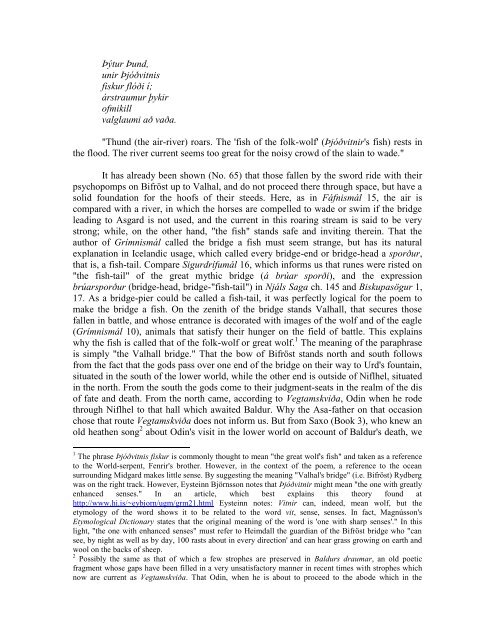Chapters 44-95 - Germanic Mythology
Chapters 44-95 - Germanic Mythology
Chapters 44-95 - Germanic Mythology
You also want an ePaper? Increase the reach of your titles
YUMPU automatically turns print PDFs into web optimized ePapers that Google loves.
Þýtur Þund,<br />
unir Þjóðvitnis<br />
fiskur flóði í;<br />
árstraumur þykir<br />
ofmikill<br />
valglaumi að vaða.<br />
"Thund (the air-river) roars. The 'fish of the folk-wolf' (Þjóðvitnir's fish) rests in<br />
the flood. The river current seems too great for the noisy crowd of the slain to wade."<br />
It has already been shown (No. 65) that those fallen by the sword ride with their<br />
psychopomps on Bifröst up to Valhal, and do not proceed there through space, but have a<br />
solid foundation for the hoofs of their steeds. Here, as in Fáfnismál 15, the air is<br />
compared with a river, in which the horses are compelled to wade or swim if the bridge<br />
leading to Asgard is not used, and the current in this roaring stream is said to be very<br />
strong; while, on the other hand, "the fish" stands safe and inviting therein. That the<br />
author of Grímnismál called the bridge a fish must seem strange, but has its natural<br />
explanation in Icelandic usage, which called every bridge-end or bridge-head a sporður,<br />
that is, a fish-tail. Compare Sigurdrífumál 16, which informs us that runes were risted on<br />
"the fish-tail" of the great mythic bridge (á brúar sporði), and the expression<br />
brúarsporður (bridge-head, bridge-"fish-tail") in Njáls Saga ch. 145 and Biskupasögur 1,<br />
17. As a bridge-pier could be called a fish-tail, it was perfectly logical for the poem to<br />
make the bridge a fish. On the zenith of the bridge stands Valhall, that secures those<br />
fallen in battle, and whose entrance is decorated with images of the wolf and of the eagle<br />
(Grímnismál 10), animals that satisfy their hunger on the field of battle. This explains<br />
why the fish is called that of the folk-wolf or great wolf. 1 The meaning of the paraphrase<br />
is simply "the Valhall bridge." That the bow of Bifröst stands north and south follows<br />
from the fact that the gods pass over one end of the bridge on their way to Urd's fountain,<br />
situated in the south of the lower world, while the other end is outside of Niflhel, situated<br />
in the north. From the south the gods come to their judgment-seats in the realm of the dis<br />
of fate and death. From the north came, according to Vegtamskviða, Odin when he rode<br />
through Niflhel to that hall which awaited Baldur. Why the Asa-father on that occasion<br />
chose that route Vegtamskviða does not inform us. But from Saxo (Book 3), who knew an<br />
old heathen song 2 about Odin's visit in the lower world on account of Baldur's death, we<br />
1 The phrase Þjóðvitnis fiskur is commonly thought to mean "the great wolf's fish" and taken as a reference<br />
to the World-serpent, Fenrir's brother. However, in the context of the poem, a reference to the ocean<br />
surrounding Midgard makes little sense. By suggesting the meaning "Valhal's bridge" (i.e. Bifröst) Rydberg<br />
was on the right track. However, Eysteinn Björnsson notes that Þjóðvitnir might mean "the one with greatly<br />
enhanced senses." In an article, which best explains this theory found at<br />
http://www.hi.is/~eybjorn/ugm/grm21.html Eysteinn notes: Vitnir can, indeed, mean wolf, but the<br />
etymology of the word shows it to be related to the word vit, sense, senses. In fact, Magnússon's<br />
Etymological Dictionary states that the original meaning of the word is 'one with sharp senses'." In this<br />
light, "the one with enhanced senses" must refer to Heimdall the guardian of the Bifröst bridge who "can<br />
see, by night as well as by day, 100 rasts about in every direction' and can hear grass growing on earth and<br />
wool on the backs of sheep.<br />
2 Possibly the same as that of which a few strophes are preserved in Baldurs draumar, an old poetic<br />
fragment whose gaps have been filled in a very unsatisfactory manner in recent times with strophes which<br />
now are current as Vegtamskviða. That Odin, when he is about to proceed to the abode which in the
















